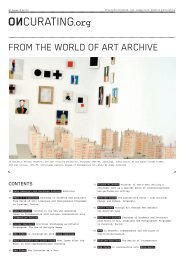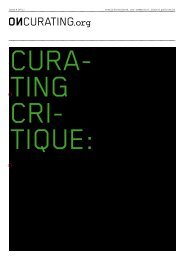Create successful ePaper yourself
Turn your PDF publications into a flip-book with our unique Google optimized e-Paper software.
062 Issue # 11/11 : PublIc Issues<br />
there is a need for developing strategies that could<br />
respond to the contingencies of differing situations. And<br />
this links back to the issue of representation, of course.<br />
Oda Projesi acts. And when these actions enter the field<br />
of presentation, an exterior of these actions starts to<br />
form and Oda Projesi is forced to somehow come out of its<br />
protective shell. Dealing with this exteriority requires<br />
cultivating strategies. This would be like a perpetual re-<br />
thinking, re-reading, and re-discussing.<br />
Özge: The issue of context is significant here. If you<br />
consider things only through the perspective of representation,<br />
the things that you see in urban life or in<br />
an exhibition come to the same level. And I don't see a<br />
problem in that. The ple<strong>as</strong>ure I derive from graffiti is<br />
the same <strong>as</strong> the ple<strong>as</strong>ure I experience in front of a piece<br />
of art. I try to read them by considering their intention<br />
or the things they represent since they result from a<br />
productive process and have become exhibits; so naturally<br />
they represent something. I guess what is problematic with<br />
the art context is that art is still conceived to be some-<br />
thing sublime while it remains part of consumer culture.<br />
Advertisements, promotion efforts, and signatures become<br />
components of the context. From our perspective, this<br />
should be something disturbing and questionable, something<br />
that leads to the problematisation of art, its circles,<br />
its buyers, exhibition openings, and modes of presentation.<br />
Problematisation may take place by writing or talking; it<br />
might also be undertaken through experimenting with<br />
exhibition making.<br />
Production of Space<br />
Derya: Can we expand a little bit more on the subject that<br />
Seçil h<strong>as</strong> just raised, namely, "temporal, nomadic, mundane,<br />
and future-less uses"? I believe these nomadic uses refer<br />
to the uses of space that Oda Projesi found already exis-<br />
ting in the neighbourhood and borrowed. It seems to me<br />
that the spatial author of the nomadic practices that you<br />
mention in the context of Galata are the neighbourhood<br />
people themselves. Don't you think so? And can we say that<br />
Oda Projesi can be defined <strong>as</strong> an author <strong>as</strong> much <strong>as</strong> it<br />
belongs to the neighbourhood? I mean <strong>as</strong> much <strong>as</strong> it contributes<br />
to the production of space in the neighbourhood.<br />
And we can even consider whether we are obliged to define<br />
the author of space.<br />
Seçil: Let's consider the neighbourhood <strong>as</strong> a stratified<br />
structure. Rigo, an apartment building built at the end of<br />
the 19th century on S¸ahkulu Street, h<strong>as</strong> a specific character<br />
with its courtyard and p<strong>as</strong>sage, while its design<br />
complied with the conditions and needs of its historical<br />
urban context. This specific architectural fabric started<br />
hosting temporary uses along with incoming migrants<br />
in the second half of the 20th century. Building blocks in<br />
this region keep changing their functions according to<br />
the endless demands of the city, and they have been main-<br />
taining their existence by being adapted to new situations.<br />
Some examples of borrowed situations are: the cons-<br />
tant changes in the courtyard; the transformation of ter-<br />
races into rooms by covering them up with walls or pl<strong>as</strong>tic<br />
panels; the iron stairc<strong>as</strong>e, which w<strong>as</strong> installed to provide<br />
a short cut to one of the flats in the upper floor and<br />
to have a visually dominant position from the top to moni-<br />
tor the courtyard; a balcony-kitchen, that is, a balcony<br />
transformed into a kitchen to create a larger cooking space<br />
for the single-room flat; clothes lines that fly over<br />
the courtyard from one window to the other... 8<br />
Özge: Probably, it is dif-<br />
ficult to talk about a state<br />
of authorship on our side<br />
unless we come up with an<br />
intervention into the space<br />
or add a piece of art onto<br />
it. Things that happen there<br />
are built upon lived experience;<br />
at that stage who is<br />
the author and who isn't<br />
becomes rather complicated.<br />
The stage that turns Oda<br />
Projesi into an author is<br />
the moment at which it<br />
claims that what is happening<br />
is an art project – now<br />
whether this happens in the<br />
neighbourhood or in the<br />
gallery doesn't matter. But<br />
in the meantime, let's<br />
also remember that we aren't<br />
making any such claim. We<br />
aren't saying that this is<br />
an art project. Instead we<br />
say that it is a proposal<br />
for an art project. Lived<br />
experience forces us to say<br />
so; that is, it remains a<br />
proposal since there are no<br />
strict definitions and rigid<br />
limitations in daily life.<br />
Derya: At this point, we can<br />
return to the issue of the<br />
production of space. Within<br />
this production, especially<br />
in the c<strong>as</strong>e of Istanbul,<br />
it is rather a confusing t<strong>as</strong>k<br />
to decide who is the author,<br />
and of what exactly. Following<br />
Antonio Negri, can we<br />
define it <strong>as</strong> the production<br />
of the common space of the<br />
metropolis, by everyone<br />
living in the city, defined<br />
<strong>as</strong> a multiplicity of complicated<br />
singularities that do<br />
not necessarily make a uni-<br />
fied and harmonious whole?<br />
What I refer to <strong>as</strong> the mis-<br />
use value of space emer-<br />
ges at this very point: the<br />
activation of the misuse<br />
value of space in Istanbul<br />
h<strong>as</strong> a profound impact on the<br />
production of urban space.<br />
Can we argue that this mode<br />
of space production, which<br />
is b<strong>as</strong>ed on the activation<br />
of the misuse value of<br />
space, h<strong>as</strong> been the dominant<br />
mode of production in Istan-<br />
bul for a long time? I'm<br />
<strong>as</strong>king this with reference<br />
to the ongoing large-scale<br />
urban renovation programmes:<br />
how does the big capital<br />
invested in urban transformation<br />
projects alter the<br />
dominant mode of space<br />
8<br />
There have been<br />
dr<strong>as</strong>tic changes in<br />
the neighbourhood<br />
since this conver-<br />
sation took place<br />
in 2006. The<br />
facades of the<br />
buildings around<br />
the courtyard have<br />
meanwhile been<br />
redone, painted,<br />
and the courtyard<br />
redesigned.<br />
The Rigo apartment<br />
block is now<br />
"secured" by two<br />
gates fitted with<br />
an electronic<br />
security system.<br />
Some of the<br />
renovated flats are<br />
being used <strong>as</strong><br />
apart-hotels and<br />
the neighbourhood<br />
is perceived by<br />
popular media <strong>as</strong><br />
one of the hip<br />
places in town.


![Download as PDF [10.6 MB]](https://img.yumpu.com/4266533/62/500x640/download-as-pdf-106-mb.jpg)

